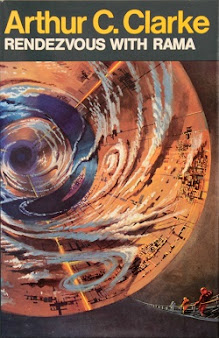Bookshot #157: Rendezvous With Rama
My parents had a couple of the Rama novels floating around when I was a kid and I think I ended up
reading one of the subsequent volumes (I want to say The Garden of Rama or Rama Revealed) I don't recall reading any of the other books, however, so when I saw that Denis Villeneuve was planning on following up his excellent adaptation of Dune with an adaptation of Rendezvous With Rama, I figured there was no better time to snag the first novel off Kindle and give it a read.
When Earth is struck by an asteroid in 2077 (landing in northeast Italy), the government of Earth sets up the Spaceguard system to make sure humanity has a reliable way to detect potential threats coming from deep space. Fifty-four years later, in the year 2131, Spaceguard picks up an unusual asteroid still outside the orbit of Jupiter and humanity quickly realizes that this one is unusual. For a start, its trajectory clearly indicates it's an interstellar object. But astronomers quickly realize that it is exceptionally large and its rotation is rapid. They name it after the Hindu God, Rama, and send an uncrewed space probe named after the Hindu Goddess Sita from Mars to photograph it. Then, the stunning truth is revealed: Rama is a perfect cylinder, 12 miles long and 40 miles wide and it's completely featureless: humanity has made first contact with an alien spacecraft.
The solar survey vessel Endeavour is the closest ship available, so it's dispatched to rendezvous with Rama and see what they can find out. A month later, they catch up to it and it's already inside the orbit of Venus. The crew, led by Commander Bill Norton enters Rama through a series of airlocks and finds an entire world inside. There are 'cities' of geometric structures separated by streets and shallow trenches. There's a band of water that stretches around the central circumference of Rama, they dub the Cylindrical Sea. Massive spires at the far southern end of Rama are theorized to be its power sources.
At first, there are no lights in Rama, so the full scale of the world is only seen in flashes, but gradually as they move deeper and deeper into Rama- they realize that the atmosphere is breathable and then... the lights come on.
As they continue to explore, they reach the sea, and eventually, a crew member, Jimmy Pak who has experience with low gravity sky bikes takes a risk in the lower gravity of Rama's higher elevations to reach the southern continent and find out the purpose of those massive spires they've been curious about. Turns out that power generation seems to be the right answer because the twin spires generate a bolt of lightning and crash his bike. Surviving the crash, he discovers that there are indigenous life forms on Rama- biological robots, or as they come to be called 'biots.' They seem to serve as leftover maintenance and waste removal drones.
The discovery of life on Rama rattles the Hermians (on Mercury) into believing that Rama is a threat, launches a missile to attempt to destroy it, but another crew member takes advantage of a lag in transmission time to go out and defuse it. Eventually, as Rama prepares to exit the solar system, the lights begin to dim and it prepares to go further on its journey. The crew evacuates and watches as it gradually plunges into the sun, soaking up power before slingshotting away in the direction of the Large Magellanic Cloud.
Overall: If there's a book that fits the whole description of 'just the facts, ma'am, it's this book. Clarke wanted to write a story about humanity discovering and exploring an interstellar and alien spacecraft/world and that's what he does. I can't say that there's a lot of character development here-- nice little touches like Commander Norton having two wives and two families and being free to sleep with whomever they like and another crew member being part of a devout future cosmic church. But it's a story with a purpose and that purpose is admirably achieved. I think I'll probably meander through the rest of this series again at some point, and hopefully we actually get a film adaptation, because if done right, I think this could be epic indeed. My Grade: *** out of ****. Solid stuff, but I've read better stuff from Clarke.



Comments
Post a Comment